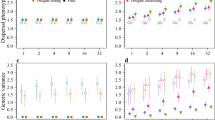Abstract
Range expansion and range shifts are crucial population responses to climate change. Genetic consequences are not well understood but are clearly coupled to ecological dynamics that, in turn, are driven by shifting climate conditions. We model a population with a deterministic reaction–diffusion model coupled to a heterogeneous environment that develops in time due to climate change. We decompose the resulting travelling wave solution into neutral genetic components to analyse the spatio-temporal dynamics of its genetic structure. Our analysis shows that range expansions and range shifts under slow climate change preserve genetic diversity. This is because slow climate change creates range boundaries that promote spatial mixing of genetic components. Mathematically, the mixing leads to so-called pushed travelling wave solutions. This mixing phenomenon is not seen in spatially homogeneous environments, where range expansion reduces genetic diversity through gene surfing arising from pulled travelling wave solutions. However, the preservation of diversity is diminished when climate change occurs too quickly. Using diversity indices, we show that fast expansions and range shifts erode genetic diversity more than slow range expansions and range shifts. Our study provides analytical insight into the dynamics of travelling wave solutions in heterogeneous environments.





Similar content being viewed by others
References
Arenas M, Ray N, Currat M, Excoffier L (2012) Consequences of range contractions and range shifts on molecular diversity. Mol Biol Evol 29(1):207–218
Balanyá J (2006) Global genetic change tracks global climate warming in drosophila subobscura. Science 313(5794):1773–1775
Barton N, Etheridge A, Kelleher J, Véber A (2013) Genetic hitchhiking in spatially extended populations. Theor Popul Biol 87:75–89
Barton NH, Etheridge AM (2011) The relation between reproductive value and genetic contribution. Genetics 188(4):953–973
Battisti A, Stastny M, Netherer S, Robinet C, Schopf A, Roques A, Larsson S (2005) Expansion of geographic range in the pine processionary moth caused by increased winter temperatures. Ecol Appl 15(6):2084–2096
Berestycki H, Rossi L (2008) Reaction-diffusion equations for population dynamics with forced speed I—the case of the whole space. Discrete Contin Dyn Syst 21(1):41–67
Berestycki H, Diekmann O, Nagelkerke CJ, Zegeling PA (2009) Can a species keep pace with a shifting climate? Bull Math Biol 71(2):399–429
Berger WH, Parker FL (1970) Diversity of planktonic foraminifera in deep-sea sediments. Science 168:1345–1347
Bonnefon O, Coville J, Garnier J, Hamel F, Roques L (2014) The spatio-temporal dynamics of neutral genetic diversity. Ecol Complex 20:282–292
Breed G, Stichter S, Crone EE (2013) Climate-driven changes in northeastern US butterfly communities. Nat Clim Change 3:142–145
Brown JH, Stevens GC, Kaufman DM (1996) The geographic range: size, shape, boundaries, and internal structure. Annu Rev Ecol Evol Syst 27(1):597–623
Burton OJ, Phillips BL, Travis JMJ (2010) Trade-offs and the evolution of life-histories during range expansion. Ecol Lett 13(10):1210–1220
Cwynar LC, Mac Donald GM (1987) Geographical variation of lodgepole pine in relation to population history. Am Nat 129:463–469
Dai Q, Zhan X, Lu B, Fu J, Wang Q, Qi D (2014) Spatial genetic structure patterns of phenotype-limited and boundary-limited expanding populations: a simulation study. PLoS One 9(1):e85778
Durrett R, Wai-Tong F (2016) Genealogies in expanding populations. Ann Appl Probab. arXiv:1507.00918v2
Edmonds CA, Lillie AS, Cavalli-Sforza LL (2004) Mutations arising in the wave front of an expanding population. Proc Natl Acad Sci USA 101(4):975–979
Estoup A, Beaumont M, Sennedot F, Moritz C, Cornuet JM (2004) Genetic analysis of complex demographic scenarios: spatially expanding populations of the cane toad, bufo marinus. Evolution 58(9):2021–2036
Excoffier L, Ray N (2008) Surfing during population expansions promotes genetic revolutions and structuration. Trends Ecol Evol 23(7):347–351
Excoffier L, Foll M, Petit RJ (2009) Genetic consequences of range expansions. Annu Rev Ecol Evol Syst 40(1):481–501
Field CB, Barros VR, Dokken DJ, Mach KJ, Mastrandrea MD, Bilir TE, Chatterjee M, Ebi KL, Estradaa YO, Genova RC, Girma B, Kissel ES, Levy AN, MacCracken S, Mastrandrea PR, White LL (eds) (2014) Climate change 2014: impacts, adaptation, and vulnerability. Part A: global and sectoral aspects. Contribution of working group II to the fifth assessment report of the intergovernmental panel on climate change. Cambridge University Press, Cambridge
Garnier J, Giletti T, Hamel F, Roques L (2012) Inside dynamics of pulled and pushed fronts. J Math Pures Appl 11:173–188
Goodsman D, Cooke B, Coltman DW, Lewis MA (2014) The genetic signature of rapid range expansions: dispersal, growth and invasion speed. Theor Popul Biol 98:1–10
Hallatschek O, Nelson DR (2008) Gene surfing in expanding populations. Theor Popul Biol 73:158–170
Hallatschek O, Hersen P, Ramanathan S, Nelson DR (2007) Genetic drift at expanding frontiers promotes gene segregation. Proc Natl Acad Sci USA 104(50):19,926–19,930
Henry RC, Bocedi G, Travis JMJ (2013) Eco-evolutionary dynamics of range shifts: elastic margins and critical thresholds. J Theor Biol 321:1–7
Hewitt GM (2000) The genetic legacy of the quarternary ice ages. Nature 405:907–913
Hill JK, Thomas CD, Blakeley DS (1999) Evolution of flight morphology in a butterfly that has recently expanded its geographic range. Oecologia 121(2):165–170
Hill JK, Hughes CL, Dytham C, Searle JB (2006) Genetic diversity in butterflies: interactive effects of habitat fragmentation and climate-driven range expansion. Biol Lett 2(1):152–154
Klopfstein S, Currat M, Excoffier L (2006) The fate of mutations surfing on the wave of a range expansion. Mol Biol Evol 23(3):482–490
Kubisch A, Hovestadt T, Poethke HJ (2010) On the elasticity of range limits during periods of expansion. Ecology 91(10):3094–3099
Leblois R, Estoup A, Streiff R (2006) Genetics of recent habitat contraction and reduction in population size: does isolation by distance matter? Mol Ecol 15(12):3601–3615
Leinster T, Cobbold C (2012) Measuring diversity: the importance of species similarity. Ecology 93(3):477–489
McInerny GJ, Dytham C, Travis JMJ (2007) Range shifting on fragmented landscapes. Ecol Inform 2:1–8
McInerny GJ, Turner JRG, Wong HY, Travis JMJ, Benton TG (2009) How range shifts induced by climate change affect neutral evolution. Proc R Soc B 276(1661):1527–1534
Nagylaki T (1975) Conditions for the existence of clines. Genetics 80(3):595–615
Nagylaki T (1980a) Geographical invariance and the strong-migration limit in subdivided populations. J Math Biol 41(2):123–142
Nagylaki T (1980b) The strong-migration limit in geographically structured populations. J Math Biol 9(2):101–114
Nei M, Maruyama T, Chakraborty R (1975) The bottleneck effect and genetic variability in populations. Evolution 29(1):1–10
Neve G, Pavlicko A, Konvicka M (2009) Loss of genetic diversity through spontaneous colonization in the bog fritillary butterfly Proclossiana eunomia (Lepidoptera: Nymphalidae) in the Czech Republic. Eur J Entomol 106(1):11–19
Nullmeier J, Hallatschek O (2013) The coalescent in boundary-limited range expansions: the coalescent in boundary-limited range expansions. Evolution 67:1307–1320
Parmesan C (1996) Climate and species’ range. Nature 382:765–766
Parmesan C (2006) Evolutionary and ecological responses to recent climate change. Annu Rev Ecol Evol 37(8):637–669
Pearson RG, Dawson TP (2003) Predicting the impacts of climate change on the distribution of species: are bioclimate envelope models useful? Glob Ecol Biogeogr 12(5):361–371
Pease CP, Lande R, Bull JJ (1989) A model of population growth, dispersal and evolution in a changing environment. Ecology 70:1657–1664
Perkins TA, Phillips BL, Baskett ML, Hastings A (2013) Evolution of dispersal and life history interact to drive accelerating spread of an invasive species. Ecol Lett 16(8):1079–87
Peterson AT, Ortega-Huerta MA, Bartley J, Sanchez-Cordero V, Soberon J, Buddemeier RH, Stockwell DRB (2002) Future projections for mexican faunas under global climate change scenarios. Nature 416(6881):626–629
Phillips BL (2012) Range shift promotes the formation of stable range edges. J Biogeogr 39(1):153–161
Pluess AR (2011) Pursuing glacier retreat: genetic structure of a rapidly expanding larix decidua population. Mol Ecol 20(3):473–485
Potapov AB, Lewis MA (2004) Climate and competition: the effect of moving range boundaries on habitat invasibility. Bull Math Biol 66(5):975–1008
Root TL, Price JT, Hall KR, Schneider SH, Rosenzweig C, Pounds JA (2003) Fingerprints of global warming on wild animals and plants. Nature 421(6918):57–60
Roques L, Garnier J, Hamel F, Klein E (2012) Allee effect promotes diversity in traveling waves of colonization. Proc Natl Acad Sci USA 109:8828–8833
Rousselet J, Zhao R, Argal D, Simonato M, Battisti A, Roques A, Kerdelhué C (2010) The role of topography in structuring the demographic history of the pine processionary moth, Thaumetopoea pityocampa (lepidoptera: Notodontidae). J Biogeogr 37:1478–1490
Samarasekera GDN, Bartell NV, Lindgren BS, Cooke JEK, Davis CS, James PMA, Coltman DW, Mock KE, Murray BW (2012) Spatial genetic structure of the mountain pine beetle (Dendroctonus ponderosae) outbreak in western Canada: historical patterns and contemporary dispersal. Mol Ecol 21:2931–2948
Schippers P, Verboom J, Vos CC, Jochem R (2011) Metapopulation shift and survival of woodland birds under climate change: will species be able to track? Ecography 34(6):909–919
Schwartz MW, Iverson LR, Prasad AM, Matthews SN, O’Connor RJ (2006) Predicting extinctions as a result of climate change. Ecology 87(7):1611–1615
Shannon CE (1948) A mathematical theory of communication. Bell Syst Tech J 27:379–423
Simmons AD, Thomas CD (2004) Changes in dispersal during species’ range expansions. Am Nat 164(3):378–395
Simpson EH (1949) Measurment of diversity. Nature 163:688
Skellam JG (1951) Random dispersal in theoretical populations. Biometrika 38:196–218
Stokes AN (1976) On two types of moving front in quasilinear diffusion. Math Biosci 31:307–315
Travis JMJ (2003) Climate change and habitat destruction: a deadly anthropogenic cocktail. Proc R Soc B 270:467–473
Travis JMJ, Mustin K, Benton TG, Dytham C (2009) Accelerating invasion rates result from the evolution of density-dependent dispersal. J Theor Biol 259(1):151–158
Travis JMJ, Delgado M, Bocedi G, Baguette M, Bartoń K, Bonte D, Boulangeat I, Hodgson JA, Kubisch A, Penteriani V, Saastamoinen M, Stevens VM, Bullock JM (2013) Dispersal and species’ responses to climate change. Oikos 122(11):1532–1540
Walther GR, Post E, Convey P, Menzel A, Parmesan C, Beebee T, Fromentin JM, Hoegh-Guldberg O, Bairlein F (2002) Ecological responses to recent climate change. Nature 416(6879):389–395
White TA, Perkins SE, Heckel G, Searle JB (2013) Adaptive evolution during an ongoing range expansion: the invasive bank vole (myodes glareolus) in ireland. Mol Ecol 22(11):2971–2985
Xin J (2000) Front propagation in heterogeneous media. SIAM Rev 42:161–230
Acknowledgments
MAL gratefully acknowledges a Canada Research Chair, a Killam Research Fellowship, Discovery and Accelerator grants from the Canadian Natural Sciences and Engineering Research Council, and the Natural Science and Engineering Research Council of Canada (Grant No. NET GP 434810-12) to the TRIA Network, with contributions from Alberta Agriculture and Forestry, Foothills Research Institute, Manitoba Conservation and Water Stewardship, Natural Resources Canada - Canadian Forest Service, Northwest Territories Environment and Natural Resources, Ontario Ministry of Natural Resources and Forestry, Saskatchewan Ministry of Environment, West Fraser and Weyerhaeuser. JG gratefully acknowledges the NONLOCAL project from the French National Research Agency (ANR-14-CE25-0013).
Author information
Authors and Affiliations
Corresponding author
Rights and permissions
About this article
Cite this article
Garnier, J., Lewis, M.A. Expansion Under Climate Change: The Genetic Consequences. Bull Math Biol 78, 2165–2185 (2016). https://doi.org/10.1007/s11538-016-0213-x
Received:
Accepted:
Published:
Issue Date:
DOI: https://doi.org/10.1007/s11538-016-0213-x




